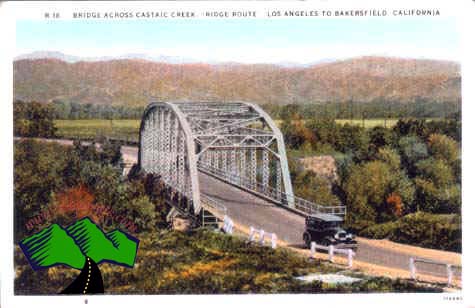
Discovery,
Find, Beginnings, Early,
Challenge, Breaking,
Paving, Residents, Tourists,
Kelly's, Conclusion
Paving
Two
years after the road opened, the Highway Commission solicited bids
to
have the Ridge Route paved. It had been necessary to allow the great
fills to settle thoroughly. There were various bids received but on
December 31 , 1917 the Commission had received only one bid in response
to its advertisement for paving all three sections. Fred Hoffman of
Long Beach offered to do the job for $575,130.
The engineers felt that the bid was too high. They calculated the paving
job should cost no more than $378,879. They did not enter into a contract,
especially as it was doubtful that the contract could be completed under
war conditions.
The Commission decided to go ahead with the paving itself in 1919 using
day laborers. They completed the job at a cost of $700,000, and claimed
a savings of $100,000 had it been done by contract even though they
had not asked for, or received, any bids since the Hoffman bid of December
31, 1917. Judging from numbers alone, it would appear that Hoffman's
bid was obviously below the Commissioner's cost, but then again, the
Commission had delayed the paving for yet another year.
Work started on the south end of the route near Castaic Wash.While work
was being done on the first eight miles, a detour was in place.Once
paving started on the Ridge itself, it was necessary to close the route
in February, 1919.
The road was paved with 4.5 inches of concrete with reinforced twisted
iron bars laid transversely 18 inches apart, and bound on either side
with rods laid lengthwise. Substantial concrete curbs were constructed
at all dangerous points, six inches wide and ten high to protect reckless
drivers and also to assist with drainage problems. The high curbs were
installed in locations where it was impossible to anchor wooden rails.
The high curbing acted as a deflector to the narrow tired vehicles should
they get too close to the edge of the cliff.
The paving completed, the road reopened November 15, 1919. The entire
job was finished except for a ten mile stretch between Lebec and Rose
Station on the Kern County side. This section was oiled. A lack of funds
prevented this section from being paved until a July bond issue was
passed. The following spring would see this section completed. During
the paving of this strip, a detour of one and one-sixth miles was necessary
in the vicinity of the famous Grapevine Circle. The detour was a 20
percent climb and the road was adobe, a dangerous soil when wet. Three
accidents happened on the detour in the first week, and motorists were
warned by guards at both ends not to attempt the steep detour unless
using low gear and having good brakes. Early cars without vacuum-feed
fuel systems would be advised not to attempt going up the detour as
the engine would ultimately be in a higher position than the gas tank.
After the Grapevine was paved and the detour eliminated, motorists still
faced a healthy seven percent grade. Many truck drivers would wait until
evening before tackling the climb to reduce the possibility of overheating.
click
here for next page









